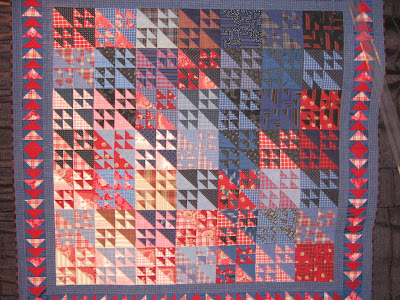Roman Stripes variation quilt, by Willie “Ma Willie” Abrams, ca. 1975. Corduroy. Courtesy of The Collection of the Tinwood Alliance; photography by Museum of Fine Arts, Houston
Now, what makes this color scheme work?
First let's consider color value. This quilt has a mixture of light, medium and dark values. Almost every quilt artist has noted that this is a hallmark of an effective design! The orange-yellow has a light value, while the chocolate brown has a very dark value, as seen on the gray scale below.
And regarding color: it seems to us that there is a clever combination of analogous and complementary colors within the quilt. Here is one section, which includes complementary hues of aqua blue and orange-red:
while other sections feature analogous hues of orange-yellow to yellow-green:
Each section of the quilt has a color scheme that is harmonious by itself. Their sophisticated use of color makes the Gee's bend quilters so impressive. Don't you think we can learn a lot by studying their quilts? Here are two books we've been enjoying: The Quilts of Gee's Bend- Masterpieces from a Lost Place
Image credits and links: The color analysis was done with Moda's Fabric Matcher. The Roman Stripes variation quilt was shown at the Museum of Fine Art in Houston; you can read about the exhibit in an article by Alvia J. Wardlaw, curator, at Antiques and Fine Art.
















